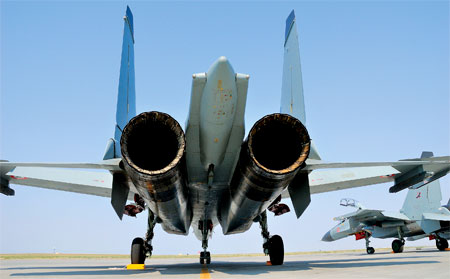INDIAN ARMED FORCES CHIEFS ON
OUR RELENTLESS AND FOCUSED PUBLISHING EFFORTS

SP Guide Publications puts forth a well compiled articulation of issues, pursuits and accomplishments of the Indian Army, over the years

I am confident that SP Guide Publications would continue to inform, inspire and influence.

My compliments to SP Guide Publications for informative and credible reportage on contemporary aerospace issues over the past six decades.
SU-30MKI - India was a Friend In Deed...

The Su-30MKI deal may have been dictated by not only India’s geopolitical compulsions but also A Benevolent Response by the Indian government to help bailout the ailing defence industry of a decades-old friend
Post-World War II, there was a resurgence in the demand for weapon systems. The Soviet defence industry was sustained in large part by the procurement of weapon systems by the large number of client states spread across the world. Emerging from centuries of subjugation, a peace-loving non-violent nation, India, in 1962 suffered a debilitating military defeat and humiliation at the hands of the Chinese, accentuating the need to build a military machine capable of safeguarding national security interests.
On account of factors—such as the stated policy of nonalignment and neutrality seeking friendship with all and conflict with none; a democratic form of governance with a strong socialistic undertone and a highly controlled economy—India was excluded from the coterie of the developed world that was in direct political and military confrontation with the USSR. Denied access to modern military technology by the West post the Sino-Indian conflict, India turned to the USSR who welcomed the opportunity with open arms, offering the latest weapon systems and technologies on highly favourable terms. Net result, after four-and-half decades of partnership, bulk of the inventory of the armed forces of India worth billions of dollars and defence production capability are of Russian origin.
The collapse of the Soviet Union in 1991 was a turning point in the history of the Russian Defence Industry. The Russian economy was in complete disarray, the defence production facilities fragmented and scattered in the different republics no longer tethered to Moscow. The end of the Cold War and the emergence of a uni-polar world eroded the market for Russian weapons among the erstwhile Warsaw Pact nations, pushing the Russian Defence Industry to the brink of collapse. China, a major buyer of Russian technology, had by then become largely self-reliant, having developed their indigenous capability. Algeria and Venezuela were the only markets that Russia had to sell weapons.
At this stage, India came to the rescue of the Russian Defence Industry. So far wedded predominantly to the MiG series of fighters, in 1996, the Indian Air Force (IAF) selected the top-of-the-line combat aircraft from Sukhoi, the Su-30, a development of the Su-27 Fulcrum platform. The version customised for the IAF was designated Su-30 MKI (‘I’ denoting India). The total deal for 230 aircraft, inclusive of licensed manufacture of 140 by the Hindustan Aeronautics Limited, was finalised without the usual global tender. Expected to be completed by 2013 or 2014, the cost is believed to be over $5 billion (Rs 25,000 crore) at prices prevailing then. For the last batch of 100 aircraft, the Russians insisted on doubling the rate of cost escalation laid down in the contract.
Undoubtedly, this mega deal of the 1990s must have administered a shot in the arm for the ailing Russian aerospace industry and has perhaps played a key role in its survival. The Su-30MKI is undoubtedly a capable machine but what did raise eyebrows is the focus on a single vendor, primarily for three reasons. Firstly, that with the demise of the Cold War, India was no longer restricted to the Russian source; but whether other options were examined and ruled out is not known. The second is that the track record of product support by Russian manufacturers in the past had been less than satisfactory. Finally, there have been serious quality issues with Russian combat aircraft operated by the IAF in large numbers, especially with the various models of the MiG-21, the MiG-23 and the MiG-29.





